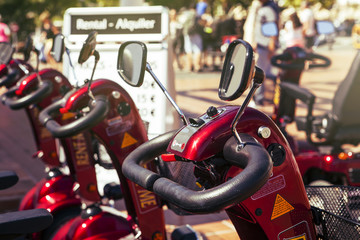It’s frustrating for many elderly or disabled people – relying on family and friends just to go to the local store or check the mail. Mobility scooters can greatly enhance the quality of people’s lives by giving them back some independence.

If you think a mobility scooter is for you, here’s what to consider before you buy.
Size
Will the scooter be an appropriate size to go to all the places you want it to? Will it fit through your door easily? Where will it be stored and recharged? Remember, you need access to a power point to charge the battery.
Lights
A scooter should have front and rear lights, including indicators and hazard lights to make it easier for drivers and pedestrians to see you, and to help you see in poor light.
Brakes
Scooters should have an automatic braking system in the event of a power failure.
Front and rear bumpers
These guard your scooter from little knocks and bumps.
Hand controls
These should be easy to reach and use. Can you adjust the steering tiller if necessary? Will you be able to use thumb controls for extended periods or does the scooter have finger controls. If not, can it be adapted for finger controls?
Wheels
Three-wheel scooters are lighter and more manoeuvrable, but four-wheelers are more stable on uneven terrain. Four-wheelers are popular for safety reasons. Most scooters can be free-wheeled, which is useful if you break down or run out of power and want someone to push it for you.
Seat
The seat should be comfortable and you’ll find it easier to get on and off if it swivels and locks in place. A fully-adjustable seat will rotate and move forwards, backwards, up and down.
Mirrors
You’ll need left and right rear vision mirrors for better visibility.
Moveable armrests
These make it easier to get on and off your scooter.
Leg room
This is especially important if you’re tall or have difficulty moving your legs.
Foot room
Make sure there is room for larger than normal shoes, like wool-lined boots, if these may be worn.
Batteries
There are two main kinds: a no-maintenance, sealed battery and a cheaper, wet cell battery that needs to be checked from time to time and may leak acid when it’s transported. Sealed batteries are more convenient and more common and are required by airlines when flying with your scooter.
Batteries are rated in amp hours. The greater the number of amp hours, the further you can travel between charging the batteries. If you need your scooter on hilly terrain or mainly for outdoor use, look for a battery size of greater than 33 amp hours, preferably over 40. Anything less than 30 amp hours is only suitable for indoor use or cruising around shopping malls.
Look for a scooter with a battery indicator so you know how much charge you have left before you need to recharge.
Battery life
To get the longest life out of your battery, recharge it as often as possible. But be aware that it may not be safe to leave your scooter on the charger for long periods. Concern has been raised that batteries shouldn’t be charged for longer than 48 hours because it may be a potential fire hazard. Whether there is a risk will depend on how the individual scooter monitors or controls the charging. Some will stop when the battery is fully charged.
We suggest you check with your scooter’s manufacturer or read your instruction manual for the recommended method to charge your battery. If you’re going on holiday or will be away from home for an extended period we suggest you disconnect the battery from the charger.
It’s also recommended you don’t let the batteries go more than half flat before you recharge them. Most scooters claim they will travel a distance of 25km or more without charging, but if you regularly let your batteries run down you’ll need to buy new ones more often.
Maximum load capacity
How much weight can the scooter carry? If you are carrying a heavy load, place it between your feet. Don’t carry it in the basket on the handle bars.
Climbing capacity
Make sure your scooter can cope with the terrain you intend to use it on – can it get up hills or is it only needed on flat terrain? You’ll need to trial this before you buy.
Distance capacity
How far will your scooter travel before it needs to be recharged? Some scooters will travel around 25km, but others will keep going for as much as 50km.
Transportation
Does it disassemble to allow transportation in a car for taking on holiday or outings?
Safe storage
Is there somewhere secure you can store your scooter where it won’t be stolen or exposed to the weather conditions?
Safety accessories
These include a horn, reversing beeper, flag and flag holder for visibility, and speed adjustment option.
Other accessories
These can include a walking stick or crutches holder, front and rear baskets, an oxygen cylinder holder, and a scooter cover.
Information supplied by consumer.org.nz










Kahu - 14 years ago
A very valuable list of information. Thankyou.